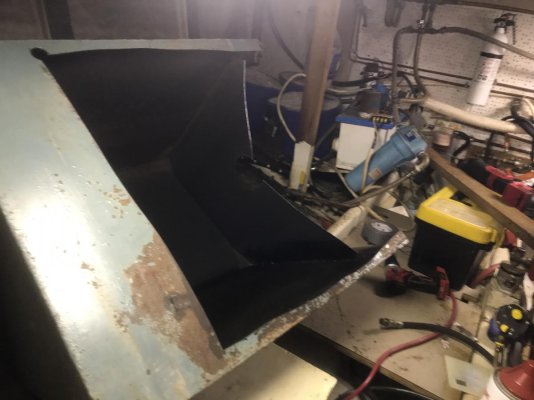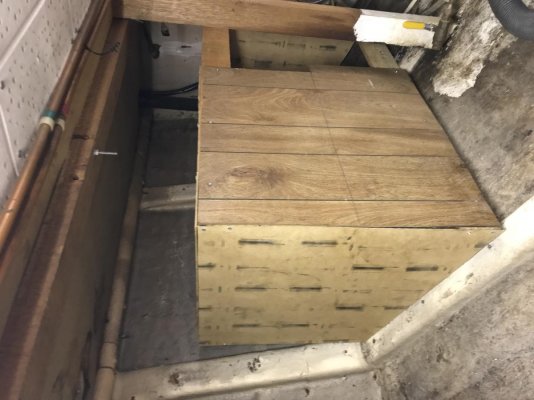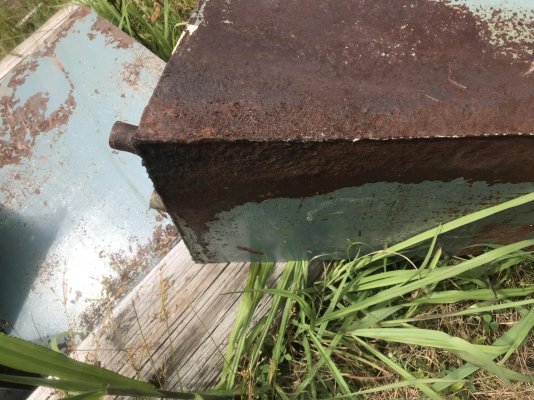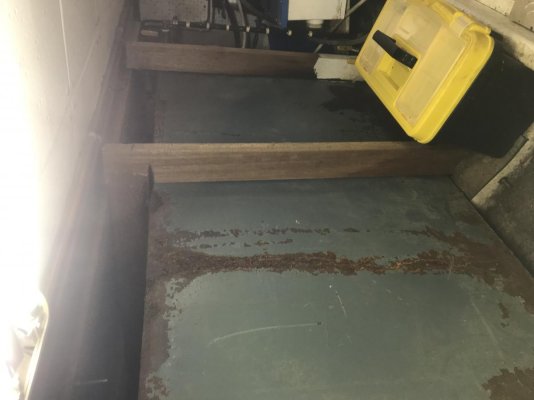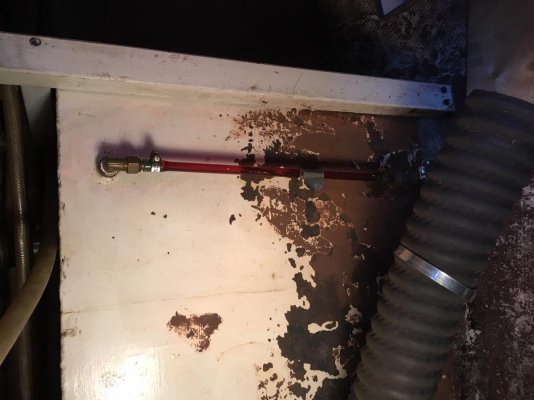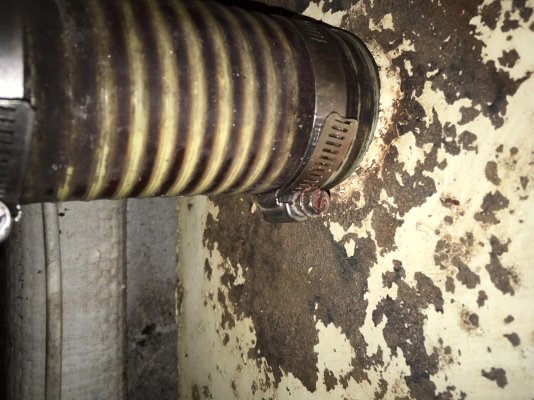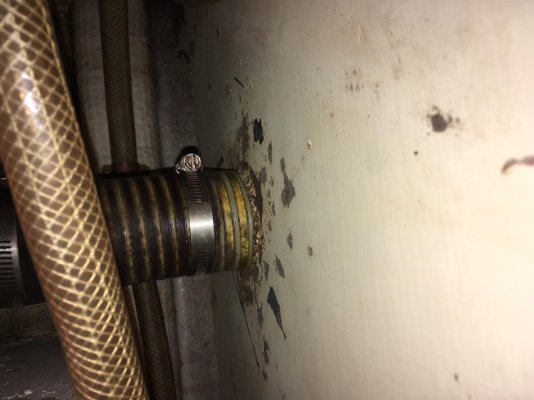Hello, I am looking at mid 1980 Taiwan built trawlers. Some have black iron diesel fuel tanks. I have no background knowledge about these type of fuel tanks. I would appreciate any comments concerning their reliability and what can be done if they develop problems (i.e. aside from finding a leak is there a way to inspect them, can they be repaired or must they be replaced, for a typical mid 1980 Taiwan trawler is repair/replace as big an undertaking as it would appear?). I realize that that there are many factors to consider for any particular boat, and that answers to board questions will be generalizations. But any information I learn will be helpful. Thanks in advance.
You are using an out of date browser. It may not display this or other websites correctly.
You should upgrade or use an alternative browser.
You should upgrade or use an alternative browser.
Black iron fuel tanks
- Thread starter mike44
- Start date
The friendliest place on the web for anyone who enjoys boating.
If you have answers, please help by responding to the unanswered posts.
If you have answers, please help by responding to the unanswered posts.
Hello, I am looking at mid 1980 Taiwan built trawlers. Some have black iron diesel fuel tanks. I have no background knowledge about these type of fuel tanks. I would appreciate any comments concerning their reliability and what can be done if they develop problems (i.e. aside from finding a leak is there a way to inspect them, can they be repaired or must they be replaced, for a typical mid 1980 Taiwan trawler is repair/replace as big an undertaking as it would appear?). I realize that that there are many factors to consider for any particular boat, and that answers to board questions will be generalizations. But any information I learn will be helpful. Thanks in advance.
There are two types of Taiwan trawlers, those that have had their fuel tanks replaced and those that need them replaced.
These tanks are NOT "black iron, they are mild steel. "Black iron" is a catchy name that some have glommed on to but is completely inaccurate.
Check out this article on Taiwan trawlers. http://onboardislandtime.com/venerable_taiwanese_trawlers.pdf
NWSeadog
Senior Member
from what I've seen the tanks fail in one of the following ways; deck leaks cause the top to rust out which is viable from the engine room or water settles to the bottom of the tank which causes it to rust out. At some point they will fail, but when is the unknown. I wouldn't necessarily avoid all boats with iron tanks if otherwise they checked all the other boxes but I would be concerned of the potential failure problem.
Portage_Bay
Guru
- Joined
- Oct 19, 2015
- Messages
- 2,453
- Location
- United States
- Vessel Name
- Pacific Myst
- Vessel Make
- West Bay 4500
I've looked at a lot of older boats with original steel tanks. Before making an offer visualize how involved it will be to get the old tanks out and new ones installed. With one exception the boats all had tanks that were in the engine room outboard of the engine(s). I imagine single engine boats would be far less trouble then twins.
I did see one clever solution on a single engine Hershine with a roomy engine room. The tanks had been replace by two on each side. Full length and full width but half height of the original tanks. Tanks on each side joined by some tight plumbing. The pair of tanks held in place by unistrut. Funky, but it would have worked except for one thing. The deck leaks were never attended to and the tops of all the tanks, 4 now instead of 2, were badly rusted to the point they were leaking.
I did see one clever solution on a single engine Hershine with a roomy engine room. The tanks had been replace by two on each side. Full length and full width but half height of the original tanks. Tanks on each side joined by some tight plumbing. The pair of tanks held in place by unistrut. Funky, but it would have worked except for one thing. The deck leaks were never attended to and the tops of all the tanks, 4 now instead of 2, were badly rusted to the point they were leaking.
FoxtrotCharlie
Guru
When we were looking we saw a lot of difference in early/mid 80's Taiwan boats vs the late 80's ones. Ours is a 1988 CHB Present - never had screwed down teak decks and all fuel/water/holding tank fills are well founded and sealed to the fiberglass - no leaks (that could be detected. We have two 120 gal fuel tanks on each side outside of the two Lehman 135's. Engines would have to be pulled to remove the tanks. But that is not an impossible feat - we pulled a huge 12.5k Westerbeke Gen out and replaced it with a 9k Kohler - took the guys about 3 hours. They said they have pulled many engines in order to change out tanks on older boats.
timb
Guru
- Joined
- Sep 12, 2017
- Messages
- 572
- Location
- usa
- Vessel Name
- true heading
- Vessel Make
- marine trader 38 dc
I have one of mine out now I'll post a few pics if I can find them. mine was rusted through a lower corner from a slow water heater leak. they were rusted badly on top also so I thought it had rusted through from inside out , but that wasn't the case . I am planning on using two plastic tanks in place of it .I will go from 145 gallons down to 100 on that side.
You can use a borescope to check interior of tank and back of tank against hull. Top of tank is visible with mirror and led light. I lightly sanded corrosion with scotchbrite pads, emery cloth, and wire brush. I was careful to not get obsessed with shiny metal. I simply knocked down the rust. Masked everything, sprayed rustoleum primer, then a finish coat. Seems to be holding up, but I do NOT leave my bilge pump on auto.
Last edited:
ben2go
Guru
Gees mate. There's nuthin wrong wif dat tank. Wire brush it, hit wif sum paint, and bob's yer ant.
In all seriousness, I have seen worse tanks have their side or top replaced, coated, and reinstalled. I don't know how they weld through the oily film, but they do it.
In all seriousness, I have seen worse tanks have their side or top replaced, coated, and reinstalled. I don't know how they weld through the oily film, but they do it.
If long-term memory serves, Ospho was the rust treatment/primer product used with success by fellow cruisers for fuel tanks. Amazon (Prime) sells it for just over half the price of West Marine. Read the Amazon reviews & pay attention to mfr. instructions. I have a shipping container being delivered this week (2nd one), & am considering using it prior to painting. Has anyone tried it?
ben2go
Guru
If long-term memory serves, Ospho was the rust treatment/primer product used with success by fellow cruisers for fuel tanks. Amazon (Prime) sells it for just over half the price of West Marine. Read the Amazon reviews & pay attention to mfr. instructions. I have a shipping container being delivered this week (2nd one), & am considering using it prior to painting. Has anyone tried it?
Thank you. That's what I was thinking of but couldn't remember the right name.
Here it is. It's not cheap but a little bit goes a long way. I've used it and it works well on old vehicles.
https://www.amazon.com/SKYBRYTE-Sky...19ac09f92d162d7087380d323495e2&language=en_US
Comodave
Moderator Emeritus
- Joined
- Jul 2, 2015
- Messages
- 21,283
- Location
- Au Gres, MI
- Vessel Name
- Black Dog
- Vessel Make
- Formula 41PC
Ours in an 87 with the original fuel tanks. They are enclosed with some sort of insulation so I cannot see much of the tanks. I can see the filler neck area and there is no visible rust there. But I am concerned about them in the long run. I am seriously considering starting this winter in replacing one of the two fuel tanks. I will have to lift the port engine and slide it over above the starboard engine for the replacement. I will also clean and paint that side of the engine room. Probably replace whatever looks questionable, water heater and water pump and clean up the wiring. There are currently no indications of a problem with the fuel tanks but I want to replace them before I get too old to be able to do it, maybe already too old... I am starting to look at my options in building a frame to hold an I beam for the trolly and hoist. I have about 1150 pounds engine and a couple of hundred more for the transmission. Anyone have an idea what size I beam I need to span 8’?
Giggitoni
Guru
- Joined
- Jun 21, 2008
- Messages
- 2,092
- Location
- United States
- Vessel Name
- Mahalo Moi
- Vessel Make
- 1986 Grand Banks 42 Classic
Ours in an 87 with the original fuel tanks. They are enclosed with some sort of insulation so I cannot see much of the tanks. I can see the filler neck area and there is no visible rust there. But I am concerned about them in the long run. I am seriously considering starting this winter in replacing one of the two fuel tanks. I will have to lift the port engine and slide it over above the starboard engine for the replacement. I will also clean and paint that side of the engine room. Probably replace whatever looks questionable, water heater and water pump and clean up the wiring. There are currently no indications of a problem with the fuel tanks but I want to replace them before I get too old to be able to do it, maybe already too old... I am starting to look at my options in building a frame to hold an I beam for the trolly and hoist. I have about 1150 pounds engine and a couple of hundred more for the transmission. Anyone have an idea what size I beam I need to span 8’?
Have you considered cutting the old tank out and save the hassle and expense of moving an engine? Put two or three smaller tanks back in and only loose about 10% of your original capacity.
Flatswing
Guru
- Joined
- Sep 21, 2016
- Messages
- 579
- Location
- United States
- Vessel Name
- River Girl
- Vessel Make
- 2004 DeFever 49 RPH
Ospho is simple to use. Wire brush the gross rust off, spray with Ospho - let dry overnight, prime/paint, no washing off or neutralization required. Usually a single quart is all you need for a lifetime. Available on the shelf at most ACE hardware stores. If u need huge quantities, buy bulk Phosphoric acid and dilute to 20%.
Portage_Bay
Guru
- Joined
- Oct 19, 2015
- Messages
- 2,453
- Location
- United States
- Vessel Name
- Pacific Myst
- Vessel Make
- West Bay 4500
Ospho is simple to use. Wire brush the gross rust off, spray with Ospho - let dry overnight, prime/paint, no washing off or neutralization required. Usually a single quart is all you need for a lifetime. Available on the shelf at most ACE hardware stores. If u need huge quantities, buy bulk Phosphoric acid and dilute to 20%.
Rust converters are commonly used on steel work boats. A combination of phosphoric acid and a water based coating. Two I've used are Conquest Rust Coverter and Corroseal Rust Converter. As with Ospho make a reasonable effort to get the loose stuff off then coat it.
FF
Guru
- Joined
- Oct 12, 2007
- Messages
- 22,552
IF the tank shows no signs of rusting , it will last "forever " if maintained.
On the outside a good coat of paint , and a check for deck leaks after a heavy rain should do.
On the inside the game is to remove any7all water.
A dip tube and hand pump might work, or fitting a simple plug on the bottom after draining .
Install a fuel rated valve and stick a plug in it when not in use, to discourage MUrphy.
Why go to expense and look for trouble with an OK tank?
NEVER emulsify the fuel in the hope the filters may catch the water.
On the outside a good coat of paint , and a check for deck leaks after a heavy rain should do.
On the inside the game is to remove any7all water.
A dip tube and hand pump might work, or fitting a simple plug on the bottom after draining .
Install a fuel rated valve and stick a plug in it when not in use, to discourage MUrphy.
Why go to expense and look for trouble with an OK tank?
NEVER emulsify the fuel in the hope the filters may catch the water.
Last edited:
Rust converters are commonly used on steel work boats. A combination of phosphoric acid and a water based coating. Two I've used are Conquest Rust Coverter and Corroseal Rust Converter. As with Ospho make a reasonable effort to get the loose stuff off then coat it.
Ospho works well but leaves a white powder residue. I think of it as an old tech, less refined, product, "since 1947". I feel obligated to clean it before I paint it.
If you google "rust converter" you will hit on a variety of more modern, more refined products. They leave a black, shiny coating that is ready to paint. Extend is another one.
Another type of rust treatment product that I haven't personally tried but will, one brand is Evaporust. There are others of the type. I've heard good feedback, no bad.
There are also electrolytic, galvanic rust treatments that are not easily applicable.
Someday I'll probably try a wet blast type of treatment for the inside of a tank but it will probably be a removable, easily washable tank. A stationary tank if I could get inside it with a water hose and a shop vac.
Surface prep, surface finish provides the resistance to corrosion, oxidation. Even if you don't spray, or brush on a coating, the surface you leave is important to resisting the elements.
Last edited:
Comodave
Moderator Emeritus
- Joined
- Jul 2, 2015
- Messages
- 21,283
- Location
- Au Gres, MI
- Vessel Name
- Black Dog
- Vessel Make
- Formula 41PC
Have you considered cutting the old tank out and save the hassle and expense of moving an engine? Put two or three smaller tanks back in and only loose about 10% of your original capacity.
I don’t think that I could even get to them well enough to even cut them up much less to put in smaller replacement tanks. It is really tight on the outboard side of the engines.
Steve91T
Guru
- Joined
- Sep 12, 2016
- Messages
- 898
- Location
- USA
- Vessel Name
- Abeona
- Vessel Make
- Marine Trader 47’ Sundeck
My boat is an 86 with original tanks. They are 4 separate tanks, 2 on each side, 150 gal each. That’s 600 gallons of fuel. My boat burns about 4 gal/hr. That’s way more fuel that I never need onboard. My plan is that if and when one starts leaking, I’ll decommission it. I’ll do the same if another starts to leak. I just hope that I’d be one on each side, not both on the same side, for balance reasons. 300 gallons will be just fine for me.
I’m hoping by the time this starts to happen I’ll have more time/money to deal with it. Most likely I’d use the original tanks as the housing to hold large bladders.
I’m hoping by the time this starts to happen I’ll have more time/money to deal with it. Most likely I’d use the original tanks as the housing to hold large bladders.
- Joined
- Nov 8, 2012
- Messages
- 2,315
- Location
- USA
- Vessel Name
- Sandpiper
- Vessel Make
- Bluewater 40 Pilothouse Trawler
My 1976 Taiwan trawler has two 300 gallon steel fuel tanks. So far no leaks.
I did open the access hatches in 2009 and cleaned the interior using a pump to spray diesel out of long tubing to reach beyond the baffles. There was no rust on the interior.
The exterior was painted on the top and front. The other sides are inaccessible.
The tanks do have deep sumps where the fuel is withdrawn along with any water that may have found it's way in. The tanks are dipped with Kolor Kut water finding paste monthly. There is a pump plumbed into the fuel system to polish any water out if present.
I leave the tanks almost empty during the winter, less than 50 gallons total. I keep the engine room heated to 50 degrees all winter to reduce condensation from the tank contracting and expanding via temperature variations. The boat resides in a boathouse.
The reason that I leave fuel tanks empty? We use around 300 to 450 gallons of fuel per year. If we fill all 600 gallons, the back of the boat gets too heavy, takes almost 2 years to use the fuel and it's a lot easier to polish 50 gallons of fuel than 600. Since the tanks are never filled completely full, it makes no difference how much fuel is in the tank when managing condensation.
I did open the access hatches in 2009 and cleaned the interior using a pump to spray diesel out of long tubing to reach beyond the baffles. There was no rust on the interior.
The exterior was painted on the top and front. The other sides are inaccessible.
The tanks do have deep sumps where the fuel is withdrawn along with any water that may have found it's way in. The tanks are dipped with Kolor Kut water finding paste monthly. There is a pump plumbed into the fuel system to polish any water out if present.
I leave the tanks almost empty during the winter, less than 50 gallons total. I keep the engine room heated to 50 degrees all winter to reduce condensation from the tank contracting and expanding via temperature variations. The boat resides in a boathouse.
The reason that I leave fuel tanks empty? We use around 300 to 450 gallons of fuel per year. If we fill all 600 gallons, the back of the boat gets too heavy, takes almost 2 years to use the fuel and it's a lot easier to polish 50 gallons of fuel than 600. Since the tanks are never filled completely full, it makes no difference how much fuel is in the tank when managing condensation.
Last edited:
FF
Guru
- Joined
- Oct 12, 2007
- Messages
- 22,552
"The tanks do have deep sumps where the fuel is withdrawn along with any water that may have found it's way in."
Your boat is very unusual in that it has an actual fuel tank , most ( US and TT) seem to only have a box for fuel, no sump.
With a properly maintained sump the need to scrap the fuel tanks never comes up.
Your boat is very unusual in that it has an actual fuel tank , most ( US and TT) seem to only have a box for fuel, no sump.
With a properly maintained sump the need to scrap the fuel tanks never comes up.
Flatswing
Guru
- Joined
- Sep 21, 2016
- Messages
- 579
- Location
- United States
- Vessel Name
- River Girl
- Vessel Make
- 2004 DeFever 49 RPH
Wow. Never heard of someone cutting out tanks that weren't leaking or visibly about to. On the smaller Grand Banks, even if one moved the engines, the only way to get old tanks out & new ones in was to remove salon windows. As a result most cut the tank up in place with a sawzall and replaced each with 2 tanks stacked vertically that could fit thru the cabin door and past the engines. Some professional yards cut holes in the side of the hull since it was cheaper and faster to get access that way. It's a hell of a lot of work to remove the baffles and smooth every edge to reuse the tanks' structures for bladders (otherwise they will chafe through). Might as well take them completely out and replace. Most tank's thru-rust are from leaking deck fittings, second: wet bilges, third:water in the fuel. BUT, there are thousands of old trawlers still doing fine with mild steel tanks (including mine). If yours are dry on top, sitting in a dry bilge & any water within is drained regularly, I couldn't justify their replacement.
psneeld
Guru
I cut mine out... no leaks.
I think there is another thing to think about.
Why wait? When problems start...its a lot of work then including miserable fuel cleaning/smell and not on your schedule.
Also...I figured out my cruising grounds and fuel requirements which sealed the deal.
I dropped down to a poly 56 gallon tank on each side. This allowed me to get EVERYTHING off the engine room decks so I have 2.5 feet working space on both sides of genset and engine...plus 3 feet in front of the genset. I also gained enough storage space after moving equipment to store tools, consumables, supplies, etc well out of the way.
It also allows much better airflow and lighting throughout.
Over 100 gallons of useable fuel (the poly tanks allow me to fill to the brim and use to the last little bit because I can see into them) still gives me 50 hrs steaming at my cruise speed. Around 300 NM range. Several times I was able to go from S. Jersey to Norfolk without refueling...but many times I short stop to get better fuel pricing or I am going into a marina to visit someplace or pumpout or water/food/etc....
Sure...not for every boat or owner...but worth considering. It worked for me with a single...not sure how it might help a boat with twins...but think of the maintenance improvement if you could get rid of tanks outboard of your engines?
Some people argue that I decreased the value of the boat....I tell them I will hopefully just sell to a smart, shorter distance cruiser who knows the value of the mod.
I think there is another thing to think about.
Why wait? When problems start...its a lot of work then including miserable fuel cleaning/smell and not on your schedule.
Also...I figured out my cruising grounds and fuel requirements which sealed the deal.
I dropped down to a poly 56 gallon tank on each side. This allowed me to get EVERYTHING off the engine room decks so I have 2.5 feet working space on both sides of genset and engine...plus 3 feet in front of the genset. I also gained enough storage space after moving equipment to store tools, consumables, supplies, etc well out of the way.
It also allows much better airflow and lighting throughout.
Over 100 gallons of useable fuel (the poly tanks allow me to fill to the brim and use to the last little bit because I can see into them) still gives me 50 hrs steaming at my cruise speed. Around 300 NM range. Several times I was able to go from S. Jersey to Norfolk without refueling...but many times I short stop to get better fuel pricing or I am going into a marina to visit someplace or pumpout or water/food/etc....
Sure...not for every boat or owner...but worth considering. It worked for me with a single...not sure how it might help a boat with twins...but think of the maintenance improvement if you could get rid of tanks outboard of your engines?
Some people argue that I decreased the value of the boat....I tell them I will hopefully just sell to a smart, shorter distance cruiser who knows the value of the mod.
Last edited:
Steve my 1985 OA has exactly the same tank arrangements and capacities you describe. My boat handles best with 50% + fuel aboard. I need all that capacity for longer trips in my part of the world and if I removed one or two of the 4 tanks I think I'd need to ballast up anyway.My boat is an 86 with original tanks. They are 4 separate tanks, 2 on each side, 150 gal each. That’s 600 gallons of fuel. My boat burns about 4 gal/hr. That’s way more fuel that I never need onboard. My plan is that if and when one starts leaking, I’ll decommission it. I’ll do the same if another starts to leak. I just hope that I’d be one on each side, not both on the same side, for balance reasons. 300 gallons will be just fine for me.
I’m hoping by the time this starts to happen I’ll have more time/money to deal with it. Most likely I’d use the original tanks as the housing to hold large bladders.
AusCan
Guru
- Joined
- Jul 15, 2012
- Messages
- 3,218
- Location
- Australia
- Vessel Name
- Kokanee
- Vessel Make
- Cuddles 30 Pilot House Motor Sailer
Its not just "black iron" tanks that suffer from corrosion. My stainless steel fuel tanks also started leaking after 35 years. This was caused by water getting underneath the tanks so they were sitting on a flat, damp base. Luckily (?) I discovered the problem as I was pulling out my 35 year old engine for replacement so it was an easy job changing them out.
Tanks will last forever as long as they stay out of contact with water, inside and out.
Tanks will last forever as long as they stay out of contact with water, inside and out.
Cigatoo
Guru
I cut mine out... no leaks.
I think there is another thing to think about.
Why wait? When problems start...its a lot of work then including miserable fuel cleaning/smell and not on your schedule.
Also...I figured out my cruising grounds and fuel requirements which sealed the deal.
I dropped down to a poly 56 gallon tank on each side. This allowed me to get EVERYTHING off the engine room decks so I have 2.5 feet working space on both sides of genset and engine...plus 3 feet in front of the genset. I also gained enough storage space after moving equipment to store tools, consumables, supplies, etc well out of the way.
It also allows much better airflow and lighting throughout.
Over 100 gallons of useable fuel (the poly tanks allow me to fill to the brim and use to the last little bit because I can see into them) still gives me 50 hrs steaming at my cruise speed. Around 300 NM range. Several times I was able to go from S. Jersey to Norfolk without refueling...but many times I short stop to get better fuel pricing or I am going into a marina to visit someplace or pumpout or water/food/etc....
Sure...not for every boat or owner...but worth considering. It worked for me with a single...not sure how it might help a boat with twins...but think of the maintenance improvement if you could get rid of tanks outboard of your engines?
Some people argue that I decreased the value of the boat....I tell them I will hopefully just sell to a smart, shorter distance cruiser who knows the value of the mod.
Makes perfect sense to me if you are cruising anywhere on the east coast burning 2-3 GPH. 50 hours takes you past a lot of refueling locations.
sunchaser
Guru
- Joined
- Apr 9, 2008
- Messages
- 10,195
- Location
- usa
- Vessel Name
- sunchaser V
- Vessel Make
- DeFever 48 (sold)
IF the tank shows no signs of rusting , it will last "forever " if maintained.
On the outside a good coat of paint , and a check for deck leaks after a heavy rain should do.
On the inside the game is to remove any7all water.
A dip tube and hand pump might work, or fitting a simple plug on the bottom after draining .
Install a fuel rated valve and stick a plug in it when not in use, to discourage MUrphy.
Why go to expense and look for trouble with an OK tank?
NEVER emulsify the fuel in the hope the filters may catch the water.
+1
NWSeadog
Senior Member
Rust is rust. Most of the issues with these tanks are related to rain water (fresh). Salt water might only make a difference if the problem was related to corrosion.Does anyone know if these tank problems are better or worse in fresh water. I am looking at a 1988 Kha Shing that appears to have a leak (diesel in the bilge). It is a one owner fresh water boat. Bill
Similar threads
- Replies
- 1
- Views
- 389

